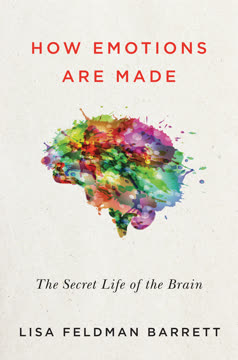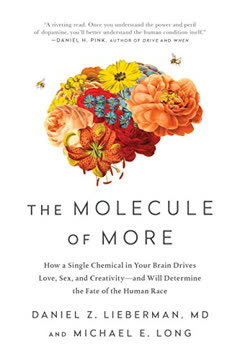Key Takeaways
1. The emotional brain evolved for survival, not conscious feelings
Emotions are indeed functions involved in survival. But since different emotions are involved with different survival functions—defending against danger, finding food and mates, caring for offspring, and so on—each may well involve different brain systems that evolved for different reasons.
Evolutionary perspective. The brain's emotion systems evolved to help organisms detect and respond to survival-relevant stimuli in the environment. These systems operate largely unconsciously, automatically triggering physiological and behavioral responses. Different emotions like fear, anger, and love serve distinct survival functions and likely involve separate neural circuits.
Unconscious processing. Much of the brain's emotional processing occurs outside of conscious awareness. Studies show that emotional stimuli can influence behavior and physiology even when presented subliminally. The brain can rapidly evaluate the emotional significance of stimuli and initiate responses before conscious awareness.
Feelings as byproducts. Conscious emotional feelings likely emerged later in evolution as a byproduct of general consciousness interacting with emotion systems. Feelings allow us to become aware of and reflect on our emotional states, but are not necessary for the adaptive functions of emotion. Understanding the survival functions of emotions, rather than just subjective feelings, is key to decoding the emotional brain.
2. Fear conditioning reveals the neural basis of emotional learning
Fear conditioning opens up channels of evolutionarily shaped responsivity to new environmental events, allowing novel stimuli that predict danger (like sounds made by an approaching predator or the place where a predator was seen) to gain control over tried-and-true ways of responding to danger.
Pavlovian conditioning. Fear conditioning involves pairing a neutral stimulus (e.g. a tone) with an aversive stimulus (e.g. a shock). After repeated pairings, the neutral stimulus alone elicits fear responses. This allows organisms to learn about new threats in the environment.
Rapid and robust learning. Key features of fear conditioning:
- Can occur after just one pairing
- Results in long-lasting memories resistant to extinction
- Involves both learned triggers and innate defensive responses
- Occurs across many species, from flies to humans
Research tool. Fear conditioning provides a powerful experimental paradigm for studying emotional learning and memory in the brain. It allows precise control over stimuli and measurement of behavioral and physiological responses. This has enabled researchers to map out the neural circuits underlying emotional learning and memory formation.
3. The amygdala is central to fear and emotional processing
The amygdala is like the hub of a wheel. It receives low-level inputs from sensory-specific regions of the thalamus, higher level information from sensory-specific cortex, and still higher level (sensory independent) information about the general situation from the hippocampal formation.
Integrating information. The amygdala integrates sensory, contextual, and memory-related information to evaluate the emotional significance of stimuli. It receives:
- Rapid, crude sensory inputs via subcortical pathways
- Detailed sensory information from cortical areas
- Contextual information from the hippocampus
Orchestrating responses. The amygdala coordinates emotional responses by:
- Triggering autonomic and hormonal changes via connections to brainstem and hypothalamus
- Modulating attention and perception via projections to sensory cortices
- Influencing memory formation through interactions with hippocampus and cortex
- Generating defensive behaviors via outputs to motor regions
Clinical relevance. Amygdala dysfunction is implicated in various emotional disorders, including anxiety, post-traumatic stress disorder, and depression. Understanding amygdala circuits provides insights into potential treatments targeting specific pathways.
4. Emotional memories and conscious memories involve different brain systems
Through brain damage we can thus see the operation of an implicit emotional memory system in the absence of explicit conscious memory of the emotional learning experience. Normally, though, in the undamaged brain, explicit memory and implicit emotional memory systems are working at the same time, each forming their own special brand of memories.
Dual memory systems. Emotional experiences involve two distinct memory systems:
- Implicit emotional memory (amygdala-dependent)
- Unconscious, automatic
- Controls physiological and behavioral responses
- Highly resistant to extinction
- Explicit declarative memory (hippocampus-dependent)
- Conscious recollection of facts and events
- Can be verbally described
- More flexible but also more fallible
Dissociation in amnesia. Patients with hippocampal damage may lose ability to consciously remember emotional events, while still showing physiological responses indicative of preserved emotional memories. This dissociation reveals the separable nature of these memory systems.
Interactions in normal function. In intact brains, these systems typically operate in parallel during emotional experiences. Explicit memories provide conscious content about emotional events, while implicit memories influence behavior and physiology, often without awareness. Understanding these distinct but interacting systems is crucial for addressing emotional disorders and trauma.
5. Stress can enhance emotional memories while impairing conscious recall
It is possible that in PTSD, as proposed for phobic learning, the direct projections to the amygdala from subcortical sensory processing regions are involved. If this were so, it would explain why the attacks are so impulsive and uncontrollable, and tend to generalize so readily (from gunshots to lightning to slamming doors).
Differential effects of stress. High levels of stress have opposing effects on memory systems:
- Enhance amygdala-dependent emotional memories
- Impair hippocampus-dependent explicit memories
Mechanisms:
- Stress hormones strengthen synapses in amygdala circuits
- Prolonged stress damages hippocampal neurons
- Prefrontal cortex function is disrupted, impairing cognitive control
Clinical implications. This differential impact helps explain symptoms of stress-related disorders:
- Intrusive emotional memories and flashbacks
- Difficulty consciously recalling details of traumatic events
- Generalization of fear to similar but safe stimuli
- Impaired ability to use context to modulate emotional responses
Understanding these mechanisms provides insights for developing targeted interventions to address stress-related memory disturbances.
6. Anxiety disorders involve dysfunction in fear and emotion circuits
Anxiety disorders reflect the operation of the fear system of the brain.
Neural basis of anxiety. Anxiety disorders likely arise from dysfunction in the brain's fear circuitry, particularly involving the amygdala and its connections. Key features include:
- Hyperactive amygdala responses to threat cues
- Impaired extinction of conditioned fear
- Weakened prefrontal cortex regulation of amygdala activity
- Enhanced generalization of fear to similar stimuli
Disorder-specific patterns. Different anxiety disorders may involve distinct patterns of dysfunction:
- Phobias: Enhanced conditioning to evolutionarily prepared stimuli
- PTSD: Stress-induced strengthening of traumatic memories
- Panic disorder: Misinterpretation of internal bodily sensations
Treatment implications. Understanding the neural underpinnings of anxiety informs treatment approaches:
- Exposure therapy targets extinction learning mechanisms
- Cognitive interventions aim to strengthen prefrontal regulation
- Medications modulate specific neurotransmitter systems involved in fear circuits
Continued research on fear systems in the brain promises to yield more precise and effective interventions for anxiety disorders.
7. Consciousness emerges from working memory processes
Working memory … corresponds to the activated information in long-term memories, the information in shortterm memories, and the decision processes that manage which information is activated in the long-term memories and retained in the shortterm memories.
Working memory model. Consciousness likely emerges from working memory processes that integrate:
- Activated long-term memories
- Information in short-term buffers
- Executive control processes
Neural substrates. Key brain regions involved:
- Lateral prefrontal cortex: Executive functions and general-purpose working memory
- Sensory cortices: Modality-specific short-term buffers
- Hippocampus and associated cortices: Long-term memory activation
Functional characteristics:
- Limited capacity (about 7 items)
- Allows manipulation and integration of information
- Enables high-level cognition and decision-making
- Provides a "global workspace" for conscious awareness
Understanding working memory mechanisms provides insights into the nature of conscious experience and its relation to other cognitive processes.
8. Emotional feelings arise when we become aware of emotional brain activity
My idea about the nature of conscious emotional experiences, emotional feelings, is incredibly simple. It is that a subjective emotional experience, like the feeling of being afraid, results when we become consciously aware that an emotion system of the brain, like the defense system, is active.
Two requirements for feelings:
- Activation of emotion systems (e.g. amygdala circuits)
- Conscious awareness of this activation via working memory
Unconscious vs. conscious emotion. Emotional responses can occur without feelings, but feelings require consciousness. This explains how emotional stimuli can influence behavior without awareness.
Implications:
- Feelings are not causes of emotional responses, but consequences
- Modulating consciousness (e.g. through mindfulness) can alter emotional experiences
- Disorders of emotional awareness may involve disrupted integration of emotion systems with working memory
This perspective shifts focus from trying to explain feelings directly to understanding:
- How emotion systems operate
- How consciousness arises
- How these interact to produce subjective experiences
By framing emotional feelings in terms of general consciousness mechanisms, this approach provides a more tractable scientific path for understanding subjective emotional experiences.
Last updated:
FAQ
What's The Emotional Brain about?
- Exploration of Emotions: The Emotional Brain by Joseph E. LeDoux explores how emotions are generated in the brain, focusing on the biological functions of the nervous system.
- Neuroscientific Perspective: The book emphasizes studying emotions as brain functions rather than merely psychological states, aiming to uncover the neural mechanisms underlying emotional experiences.
- Key Themes: It discusses the evolutionary basis of emotions, the distinction between conscious feelings and unconscious emotional processes, and the role of different brain systems in mediating specific emotions.
Why should I read The Emotional Brain?
- Understanding Emotions: The book provides insights into the complex nature of emotions, which are integral to human experience, helping readers understand the biological underpinnings of feelings like fear, love, and anger.
- Scientific Approach: LeDoux's work is grounded in empirical research, making it valuable for those interested in psychology, neuroscience, or mental health, bridging the gap between scientific inquiry and everyday emotional experiences.
- Practical Implications: The findings have implications for mental health, offering a deeper understanding of emotional disorders and how they can be treated.
What are the key takeaways of The Emotional Brain?
- Emotions as Biological Functions: Emotions are viewed as biological functions of the nervous system, shaped by evolution to enhance survival, changing how we perceive emotional experiences.
- Conscious vs. Unconscious: Many emotional responses occur unconsciously, challenging the notion that we are always aware of our emotional processes, aligning with Freud's idea of the unconscious.
- Diverse Emotional Systems: Different emotions are mediated by distinct neural systems, suggesting no single "emotion" center in the brain, reflecting the varied functions emotions serve in our lives.
What is the significance of fear in The Emotional Brain?
- Focus on Fear: Fear is used as a primary example to illustrate how emotional systems operate in the brain, being crucial for survival and among the most studied emotional reactions.
- Fear Conditioning: The book discusses fear conditioning as a method to study how fear responses are learned and expressed, involving pairing a neutral stimulus with an aversive event.
- Neural Pathways: LeDoux outlines the neural pathways involved in fear responses, particularly the role of the amygdala, essential for grasping how fear is processed in the brain.
How does The Emotional Brain differentiate between emotions and feelings?
- Emotions vs. Feelings: Emotions are biological responses to stimuli, while feelings are the conscious experience of those emotions, crucial for understanding how emotions operate in the brain.
- Unconscious Processing: Many emotional responses occur without conscious awareness, meaning feelings are just one aspect of the broader emotional experience.
- Implications for Mental Health: Recognizing the difference can inform therapeutic approaches to emotional disorders, suggesting addressing underlying emotional processes may be more effective.
What role does the amygdala play in emotions according to The Emotional Brain?
- Central Role in Fear: The amygdala is identified as a key structure in the brain's fear response system, processing emotional stimuli and triggering appropriate defensive behaviors.
- Connections to Other Regions: It receives inputs from various brain regions, allowing it to quickly assess threats, crucial for survival.
- Impact on Emotional Learning: The amygdala is involved in fear conditioning, associating neutral stimuli with aversive experiences, essential for adapting to potential dangers.
How does fear conditioning work according to The Emotional Brain?
- Association of Stimuli: Fear conditioning occurs when a neutral stimulus is paired with an unconditioned stimulus that elicits a fear response, leading to the neutral stimulus alone triggering the fear response.
- Role of the Amygdala: The amygdala processes the emotional significance of stimuli, connecting with various brain regions to elicit responses to perceived threats.
- Different Outputs for Responses: Different outputs from the amygdala control various conditioned fear responses, allowing for tailored responses to different types of threats.
How does stress affect memory according to The Emotional Brain?
- Impact on the Hippocampus: Stress can impair the functioning of the hippocampus, leading to difficulties in forming and retrieving explicit memories, with prolonged stress causing structural changes.
- Indelible Emotional Memories: Stress may disrupt explicit memory but can enhance the strength of implicit emotional memories, leaving lasting emotional imprints.
- Vicious Cycles of Anxiety: Stress can create a feedback loop where heightened emotional responses lead to increased anxiety, perpetuating anxiety disorders.
What is the role of the prefrontal cortex in emotional regulation as described in The Emotional Brain?
- Cortical Control Over Amygdala: The prefrontal cortex helps regulate the amygdala's output, allowing for conscious control over emotional responses, crucial for extinguishing conditioned fear responses.
- Executive Functions: It is involved in working memory and decision-making processes, essential for evaluating emotional situations and guiding appropriate responses.
- Impact of Stress on Function: Stress can impair the prefrontal cortex, reducing its ability to regulate emotional responses, leading to heightened emotional reactivity.
How does The Emotional Brain explain the persistence of phobias?
- Preparedness Theory: Humans are evolutionarily predisposed to develop fears of certain stimuli, making phobias particularly resistant to extinction.
- Conditioned Responses: Phobias often result from fear conditioning, where a neutral stimulus becomes associated with a traumatic event, with the amygdala ensuring strong and enduring responses.
- Cognitive Factors: Cognitive appraisals and explicit memories can reinforce phobias, even without a clear traumatic memory, perpetuating the phobic response.
What insights does The Emotional Brain provide for treating anxiety disorders?
- Understanding Mechanisms: Understanding brain mechanisms underlying fear and anxiety can help develop more effective treatment strategies, recognizing the roles of the amygdala and prefrontal cortex.
- Exposure Therapy: It can help extinguish conditioned fear responses by gradually exposing individuals to their fears, relying on the prefrontal cortex's ability to regulate the amygdala.
- Pharmacological Interventions: Medications targeting the fear system can help manage anxiety disorders, modulating the amygdala's activity and improving emotional regulation.
What are the best quotes from The Emotional Brain and what do they mean?
- “The word ‘emotion’ does not refer to something that the mind or brain really has or does.”: Emphasizes that emotions are labels for complex brain functions rather than distinct entities, challenging the notion of a singular emotional faculty.
- “Freud was right on the mark when he described consciousness as the tip of the mental iceberg.”: Highlights that much of our emotional processing occurs unconsciously, underscoring the importance of exploring unconscious aspects of emotions.
- “Emotions are things that happen to us rather than things we will to occur.”: Reflects the idea that emotions are often automatic responses to stimuli, suggesting understanding emotions requires recognizing their involuntary nature.
Review Summary
The Emotional Brain is a comprehensive exploration of emotions and their neurobiological basis. While praised for its scientific depth and insights into fear and anxiety, many readers found it challenging due to its technical language and focus on brain anatomy. The book offers valuable information on how emotions work, particularly fear, and their evolutionary purpose. However, some felt it was dated and overly focused on fear at the expense of other emotions. Despite its complexity, many readers appreciated LeDoux's thorough approach to the subject.
Similar Books









Download PDF
Download EPUB
.epub digital book format is ideal for reading ebooks on phones, tablets, and e-readers.





